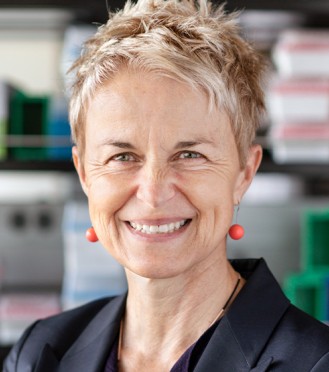Gladstone NOW: The Campaign Join Us on the Journey✕

Director of the Gladstone Institute of Virology Melanie Ott and Postdoctoral Scholar Albert Vallejo-Gracia discovered a critical role for a cell stress pathway in HIV latency.
A person living with HIV can keep the virus in check by adhering to daily treatment with antiretroviral drugs. But a true cure remains elusive.
HIV remains incurable because it hides in a latent state within cells of the immune system. If a patient stops taking their daily medication, the virus will re-emerge, multiply, and cause deadly symptoms.
Hoping to cure HIV once and for all, some scientists are pursuing a “shock and kill” approach, in which latent HIV is deliberately reactivated so the latently infected cells can be targeted and killed—either by drugs or the immune system—to completely eliminate the virus.
However, medications to “shock” HIV out of latency have not yet been successful in clinical trials, and some have toxic side effects.
Now, a team of scientists at Gladstone Institutes has discovered that HIV latency is linked to a cellular pathway known as endoplasmic reticulum (ER) stress. As reported in the journal Nature Microbiology, this breakthrough points to potential targets for drugs that could reawaken latent HIV.
“Antiretrovirals have been hugely successful for managing HIV, but latency is the final unsolved part of the equation,” says Melanie Ott, MD, PhD, director of the Gladstone Institute of Virology and senior author of the study. “We hope the new pathway we uncovered can be exploited to activate the latent virus and fully eliminate it.”
Following the Thread of FOXO1
The team’s discovery stems from earlier research into a protein called FOXO1. In T cells, the type of immune cell in which HIV hides, FOXO1 helps keep the cells from being activated when they’re not needed. As a result, the researchers hypothesized that it could play an important role in HIV latency.
Sure enough, they found that treating latently infected cells with a drug that inhibits FOXO1, reactivated HIV in both laboratory cell lines and cells from HIV-infected patients.
Next, the researchers set out to decipher the mechanism by which FOXO1 affects HIV latency.
They expected this mechanism would revolve around the metabolic pathways that FOXO1 controls. But by looking at changes in which genes were turned on or off in the cells, they found that FOXO1 inhibition boosts expression of key genes involved in ER stress. ER stress is a condition in which unneeded proteins accumulate inside the cell.
“We were quite surprised when ER stress emerged,” said Ott, who is also a professor of medicine at UC San Francisco. “It’s an incredible illustration of how science can thwart expectations and lead to new discoveries.”
Further experiments in cell lines and cells from HIV-infected patients clarified the big picture: FOXO1 inhibition reduces expression of genes that help cells degrade unnecessary components. As a result, unneeded proteins build up and cause ER stress. ER stress then activates two key proteins that promote the reactivation of latent HIV.
“It was really beautiful, as a scientist, to see the initial effects of FOXO1 inhibition and then to pull all the pieces of the puzzle together and see that they ultimately made sense,” said Albert Vallejo-Gracia, PhD, a postdoctoral scholar in Ott’s lab and first author of the study.
New Angles to Tackle HIV Infection
This study suggests that activating ER stress could help reactivate latent HIV as part of a “shock and kill” approach, perhaps in combination with existing drugs.
“It may be that existing latency-reversing drugs have not shown success because they are not sufficient to trigger HIV reactivation on their own,” Vallejo-Gracia said. “Combining them with drugs that target this new pathway might boost reactivation so that the cells can be killed and the virus eliminated.”
Indeed, the researchers found that FOXO1 inhibition acted synergistically with another latency-reversing drug to increase HIV reactivation in infected cells.
They also found that inhibiting FOXO1 in newly infected cells prevented latency from being established in the first place, suggesting a second treatment possibility apart from “shock and kill”: newly infected patients could be treated with a FOXO1 inhibitor drug to reduce the number of cells that become latently infected.
Ultimately, because of the complexity of HIV infection, it is unlikely that any single drug could cure HIV on its own. “The scientific community generally recognizes that curing HIV for different patients will probably require different combinations of strategies that attack the virus from diverse angles,” Ott said.
Beyond the clinical implications, this study expands understanding of the basic biology of T cells. In particular, second author Irene Chen, a graduate student in Ott’s lab, hopes to follow up on the causes and effects of the protein build-up they observed—a phenomenon that is more often studied in the context of dementia in brain cells.
“With this study, we were able to tell a comprehensive story that would not have been possible without our collaborators, especially those at the Buck Institute and the Vitalant Research Institute,” Ott said. “These kinds of collaborations are essential for interesting, successful science.”
For Media
Julie Langelier
Associate Director, Communications
415.734.5000
Email
About the Study
Other authors on the study include Gladstone researchers Daniela Boehm, Karsten Krey, Philip Ansumana Hull, and Ireneusz Habrylo; UC San Francisco researcher Steven Deeks; Kyle Raymond and Satish Pillai of the Vitalant Research Institute; and Rosalba Perrone, Emilie Besnard, Emilie Battivelli, Tugsan Tezil, Marius Walter, Andrew Cruz, and Eric Verdin of the Buck Institute for Research on Aging.
Funding was provided by the National Institutes of Health and the amfAR Institute for HIV Cure Research.
About Gladstone Institutes
Gladstone Institutes is an independent, nonprofit life science research organization that uses visionary science and technology to overcome disease. Established in 1979, it is located in the epicenter of biomedical and technological innovation, in the Mission Bay neighborhood of San Francisco. Gladstone has created a research model that disrupts how science is done, funds big ideas, and attracts the brightest minds.
Genomic Maps Untangle the Complex Roots of Disease
Genomic Maps Untangle the Complex Roots of Disease
Findings of the new study in Nature could streamline scientific discovery and accelerate drug development.
News Release Research (Publication) Marson Lab GenomicsSix Gladstone Scientists Named Among World’s Most Highly Cited Researchers
Six Gladstone Scientists Named Among World’s Most Highly Cited Researchers
The featured scientists include global leaders in gene editing, data science, and immunology.
Awards News Release Corces Lab Doudna Lab Marson Lab Pollard Lab Ye LabThe Genome Editing Playbook Is Different in Neurons
The Genome Editing Playbook Is Different in Neurons
The striking findings of a new study could influence how gene therapies are designed for many genetic diseases.
News Release Research (Publication) Neurological Disease Conklin Lab Doudna Lab CRISPR/Gene Editing




